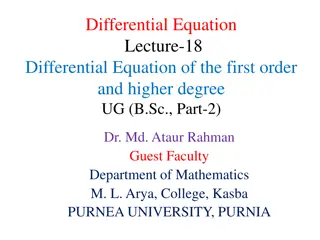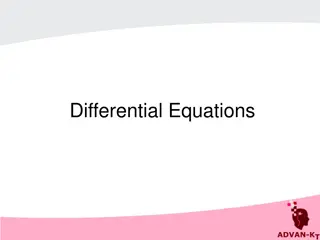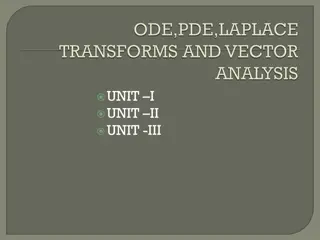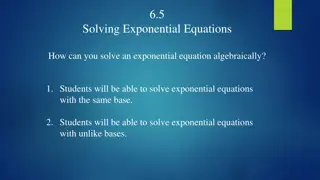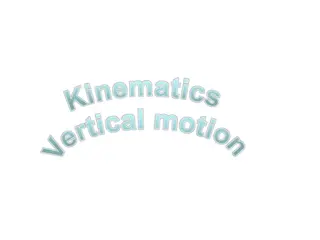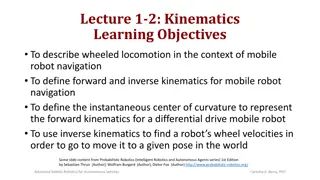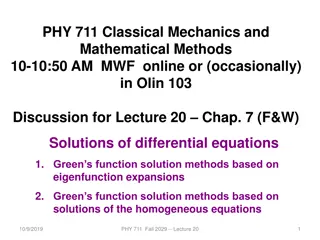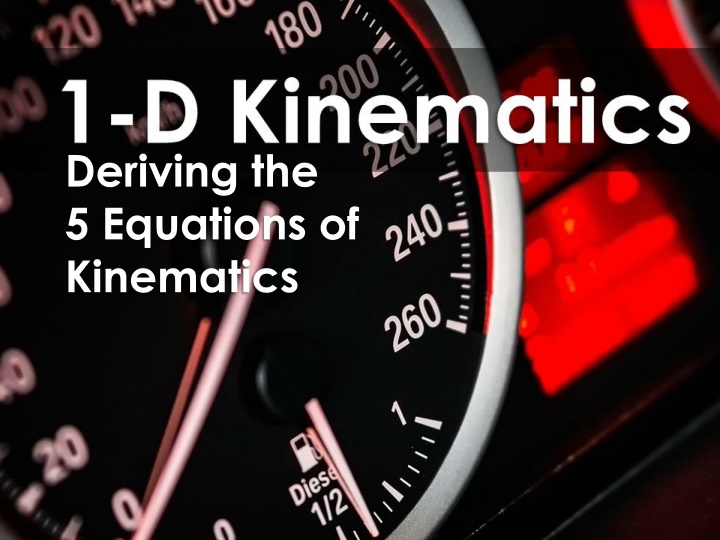
Equations of Kinematics: Derivation and Explanation
Learn how to derive the 5 equations of kinematics using algebraic methods instead of graphing. Understand the patterns and variables involved in solving problems related to displacement, velocity, acceleration, and time.
Download Presentation

Please find below an Image/Link to download the presentation.
The content on the website is provided AS IS for your information and personal use only. It may not be sold, licensed, or shared on other websites without obtaining consent from the author. If you encounter any issues during the download, it is possible that the publisher has removed the file from their server.
You are allowed to download the files provided on this website for personal or commercial use, subject to the condition that they are used lawfully. All files are the property of their respective owners.
The content on the website is provided AS IS for your information and personal use only. It may not be sold, licensed, or shared on other websites without obtaining consent from the author.
E N D
Presentation Transcript
Deriving the 5 Equations of Kinematics
Deriving the 5 Equations of Kinematics Though graphing is a powerful tool it takes a lot of time to solve problems. If we create a generic graph, one with variables instead of set values, we can derive equations that will allow us to solve problems algebraically instead of graphically.
Deriving the 5 Equations of Kinematics There are 5 main equations of Kinematics that involve 5 variables: ? - displacement ?1 - initial velocity ?2 - final velocity ? - acceleration ? - elapsed time
Deriving the 5 Equations of Kinematics The following 5 equations are useful for situations involving constant acceleration. If a problem involves constant velocity these equations should not be used use ? = ? If a variable appears in the equation place a checkmark in the box next to that equation. ?instead.
Deriving the 5 Equations of Kinematics Equation ? ?1 ?2 ? ? 1 ?2= ?1+ ? ? ? =1 2 ?2+ ?1 ? 2 ? = ?1 ? +1 2 ? ?2 3 ? = ?2 ? +1 2 ? ?2 4 2= ?1 2+ 2 ? ? 5 ?2
Deriving the 5 Equations of Kinematics Equation ? ?1 ?2 ? ? 1 ?2= ?1+ ? ? ? =1 2 ?2+ ?1 ? 2 ? = ?1 ? +1 2 ? ?2 3 ? = ?2 ? +1 2 ? ?2 4 2= ?1 2+ 2 ? ? 5 ?2
Deriving the 5 Equations of Kinematics After you ve examined all 5 equations, what pattern do you notice? Each equation involves 4 of the 5 possible variables. One variable is excluded from each equation.
Deriving the 5 Equations of Kinematics Deriving Equation 1 Derivation Explanation Draw a generic ? ? graph No units or values needed Draw a line to show constant acceleration Label points ?1, ?1 & ?2, ?2 on the line ?? ?? ?? ??
Deriving the 5 Equations of Kinematics Deriving Equation 1 Derivation Explanation Recall, slope of a ? ? graph gives acceleration. ? =???? ??? ? = ?2 ?1 ?2 ?1 ? = ?2 ?1 Find the slope. ?2 ?1= ? ?
Deriving the 5 Equations of Kinematics Deriving Equation 1 Derivation Explanation Rearrange to solve for ?2, a variable we often want to solve for. ? ? = ?2 ?1 ? ? + ?1= ?2 ?1+ ?1 ? ? + ?1= ?2 or ?2= ?1+ ? ? This equation also comes from the definition of acceleration.
Deriving the 5 Equations of Kinematics Deriving Equation 2 Derivation Explanation Draw a generic ? ? graph No units or values needed Draw a line to show constant acceleration Label points ?1, ?1 & ?2, ?2 on the line ??,?? ?? ?? ?? ?? ??,?? ?? ?? ?? ?? ?? ?? ??
Deriving the 5 Equations of Kinematics Deriving Equation 2 Derivation Explanation Recall the area under a section of a graph gives the displacement for that period. ??,?? ?? ?? ?? ?? ??,?? ?? ?? ?? ?? ?? ?? ??
Deriving the 5 Equations of Kinematics Deriving Equation 2 Derivation Explanation Find the area. ? = ???? ? = ?1+ ?2 ? = ? ? +1 2?
Deriving the 5 Equations of Kinematics Deriving Equation 2 Derivation Explanation ?2 ?1= ? ?1 +1 ? = ?2 ?1 2?2 ?1 ?2 ?1 Distribute ? in second term. ?1 +1 ? = ? 2 ? ?2 ?1 Distribute 1 second term. 2 in ? = ?1 ? +1 ?2 ? ?1 ? 2 Collect like items. ? = 1 ?1 ? +1 2 ?2 ? 1 2 ?1 ? Common factor 1 2 & ?
Deriving the 5 Equations of Kinematics Deriving Equation 2 Derivation 2 ?2 ? +1 ?2 ? +1 Explanation ?2 ?1= ? ? =1 2 ?1 ? Distribute ? in second term. ? =1 2 ?1 ? 2 Distribute 1 term. 2 in second ? =1 ?2+ ?1 ? 2 Collect like items. Common factor 1 2 & ?
Deriving the 5 Equations of Kinematics Between equations 1 and 2 all five variables are present. The remaining equations are found by using substitution or elimination to remove one variable the variable that is not present in the final equation. For example, equation 3 does not contain the final velocity, ?2, so that is the variable that gets eliminated.
Deriving the 5 Equations of Kinematics Deriving Equation 3 Derivation Explanation Equation 3 does not involve ?2, so replace ?2 with what it is equivalent to. ?2= ?1+ ? ? ? =1 2 Sub into ? =1 2 1 ?2+ ?1 ? 2 1 2 Collect like terms within the brackets. ?1+ ? ?+ ?1 ?
Deriving the 5 Equations of Kinematics Deriving Equation 3 Derivation Explanation Distribute the 1 ? =1 22 ?1+ ? ? ? ?1+1 2 ? ? ? 2 Distribute the ? ? = Note here just ? is squared. Not ? Not 1 ? = ?1 ? +1 2 ? ?2 2
Deriving the 5 Equations of Kinematics Deriving Equation 4 Derivation Explanation Very similar derivation to equation 3, just eliminate ?1 instead of ?2. ?2= ?1+ ? ? ?2 ? ? = ?1 ? =1 2 Sub into ? =1 2 1 2 ?2+ ?1 ? 1 2 ?2+ ?2 ? ? ?
Deriving the 5 Equations of Kinematics Deriving Equation 4 Derivation Explanation ? =1 22 ?2 ? ? ? ?2 1 2 ? ? ? ? = ? = ?2 ? 1 2 ? ?2
Deriving the 5 Equations of Kinematics Deriving Equation 5 Derivation Explanation Similar derivation to equations 3 & 4, just begin by eliminating ?. ?2= ?1+ ? ? ?2 ?1 1 = ? ? ? =1 ?2+ ?1 ? 2 2 Sub into 1 2 ? =1 ?2 ?1 ? ?2+ ?1 2
Deriving the 5 Equations of Kinematics Deriving Equation 5 Derivation Explanation Multiply both sides by 2 ?. 2 ? ? =1 ?2 ?1 ? ?2+ ?1 2 ? 2 The right side represents a difference of squares: ? + ? ? ? = ?2 ?2 2 ? ? = ?2+ ?1 2 ? ? = ?2 2 ? ? + ?1 2= ?1 ?2 ?1 2 ?1 2= ?2 2+ 2 ? ? 2 2 ?2 2 Solve for ?2



